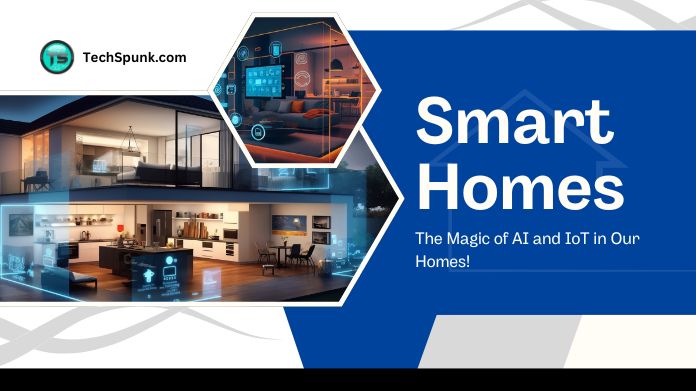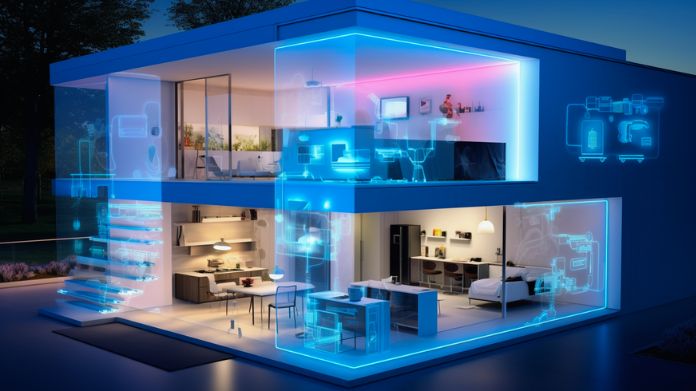What if we told you that you could live in a home that can draw curtains for you when you wake up? Or what if your house was smart enough to inform you that your furnace will break down soon?
If you are interested in making your home smarter, then this blog is for you!
Technology simplifies our lives on multiple fronts. With gadgets available for every feat, our lives are easier.
Similarly, technology has made many advancements on the lifestyle front as well. With innovations like the Internet of Things (IoT) and Artificial Intelligence (AI), smart homes are now a fascinating reality.
Let us get into how these technologies are making our homes smarter.
Table of Contents
What Are Smart Homes?
 A smart home is a system of interconnected devices and gadgets that work together to improve your home’s comfort. The internet allows them to be connected to each other.
A smart home is a system of interconnected devices and gadgets that work together to improve your home’s comfort. The internet allows them to be connected to each other.
This means items like refrigerators, vacuums, lighting, temperature control, and security alarms are interconnected.
Smart homes allow homeowners to remotely control these items from their phones. All they need is a stable WiFi connection, which is a crucial requirement for smart homes to function.
Smart home systems work on two integral technologies i.e., IoT and AI. These technologies enable the devices to remain connected and work intelligently to cater to human preferences.
It is due to these benefits that many US smart home startups are contributing to the smart home market.
How The IoT Makes Homes Smarter?
IoT, or the Internet of Things, is a network of interconnected ‘things’ or devices through the Internet. These devices have sensors that allow them to share data with each other. IoT has many industrial applications, but it is also used in smart home systems.
So, in a smart home, IoT is the technology that forms a network of all the devices and appliances.
Imagine this scenario: A sudden ice storm causes the indoor temperature to drop. The homeowner, who is away from home, is notified about that, and they can remotely turn on the heating from their smartphone.
So when they get back home, it is all warm and toasty inside. What entailed during the entire process was that the IoT sent the data (indoor temperature dropping) to the homeowner’s smartphone.
Now, since the thermostat was also part of the IoT, the homeowner was able to turn on the heating remotely. This interconnectivity and remote access of the devices is how IoT makes homes smarter.
How AI Makes Homes Smarter?
AI brings the intelligent aspect into smart homes. Smart homes have devices and sensors powered by machine learning, computer vision, or natural language processing.
These three are basic AI technologies, and they are what make stuff intelligent or smarter.
They have been detailed below:
- Machine learning empowers systems to make decisions on their own. For example, an AI-powered home assistant can decide when to turn on the heating by analyzing the temperature.
- Computer vision allows systems to process and recognize images. An AI-enabled security system can detect when a stranger is lurking around the home and send an intruder alert to the homeowner.
- Natural language processing allows systems to converse with humans. This means that homeowners can give verbal instructions to an AI-powered home assistant, such as switching on the light, deactivating security alarms, or asking about the outdoor temperature.
Now that we have a fair idea of how AI and IoT power smart homes, we have demonstrated some practical applications of smart homes to help you understand better.
Smart Homes: Practical Applications and Examples
1. Lighting
Lighting control is probably one of the most popular examples of smart homes. These smart lights are voice-activated and have varying brightness levels. You can control these lights by giving verbal instructions.
Moreover, these lights are energy-efficient and automatically turn off when no one is in the room.
AI gives lighting a personalized touch by considering your preferences, whether you prefer warm lighting or white lights in your rooms. Lastly, you can get the energy consumption data for smart lights as well.
2. Voice Assistants
Voice assistants are an important part of smart homes. Think of Google Home or Amazon Echo controlling our smart homes based on our instructions.
They interact with the homeowners through a device or an application. Voice assistants have a variety of benefits.
You can set reminders with the assistant, such as turning off the yard lights at sunrise or charging the Roomba at noon.
Plus, these smart assistants function on predictive machine-learning algorithms, which means that they can keep an eye on your home’s upkeep.
3. Security
Most smart homes have smart security systems. These systems include smart cameras, motion sensors, automatic locks, alarms, etc. These work together to make your home secure.
Most of these smart devices are AI-enabled and detect activities in real time. Things like video doorbells and cameras send live feeds to your phone so you can keep an eye on your home even when you are away from it.
4. Appliances
Smart appliances are individual devices that have intelligent capabilities to improve living experiences. These are usually voice-activated or are controlled through a mobile application.
Smart appliances include robotic vacuum cleaners like Roombas, air purifiers, intelligent baby monitors, refrigerators, precision ovens, and other appliances.
IoT connects these appliances, which allows them to send data to your phones, keeping you in the loop about each of their progress.
5. Sensors
There is a variety of smart sensors that make our homes safer and more efficient. Temperature sensors keep the temperature and humidity levels inside the house in check.
Carbon monoxide detectors and smoke detectors keep the homeowners informed in their absence. Gas and water leak sensors prevent the wastage of these resources.
These sensors send data to your device so you can get real-time insights into their homes.
How to Turn Your Home Into a Smart Home?
 It might seem like smart homes are a hefty investment, but you can choose to be smart about it (pun intended).
It might seem like smart homes are a hefty investment, but you can choose to be smart about it (pun intended).
Instead of upgrading to a full-fledged smart home system, you can gradually upgrade each component.
While making these purchases, you need to be mindful of buying devices that are compatible with each other.
For example, Google Home functions best on a Google phone. So, while making purchases, you should check the ‘compatible with’ section.
Let us have a look at the best smart appliances you can buy for your home. The list does not have Google Home, Amazon Echo, or Apple HomePod. Instead, it has smart devices that are lesser known to the masses. You can buy these and make your life so much easier.
Devices to Make Your Home Smart With
1. IRobot Roomba j9+:
We shouldn’t have to convince you to buy a Roomba, right?
This model of Roomba has a better battery life and suction power than its predecessor. Its price might be too much ($899), but the ease makes it worth it.
Imagine something vacuuming your home without you having to do anything. Convenient, right?
2. Instant Pot Pro Plus
Instant pots are such a rage compared to slow cookers. But this Instant Pot connects to a mobile app, which lets you cook through your phone. It is not heavy on the pocket and connects to your WiFi.
Imagine that you need to put your toddler to sleep but also need to turn the pot off. You can switch it off from your phone while humming your baby to sleep.
3. Gardena Sileno City Robotic Lawn Mower
Lawn mowing is a tedious task, especially when it is too hot outside.
You can get Gardena Sileno City’s robotic lawn mower, which connects through Bluetooth and has a commendable cutting performance.
The best part is that it is not as pricey as other fancy lawnmowers and is not noisy at all.
4. Nanit Pro Complete Monitoring System
More than a simple baby monitor, the Nanit Pro system allows you to monitor your baby in detail.
Apart from viewing them through an HD and night vision camera, you can also monitor their breathing and growth. You can do this with its breathing bands and smart sheets that come with the package.
The Nanit app has a user-friendly interface through which you can monitor your baby.
5. Dyson Purifier Cool TP07
Instead of buying an air purifier, you should get the two-in-one Dyson Purifier Cool TP07. It is an air purifier with a HEPA filter.
It also doubles as an oscillating fan. Moreover, it is automatic and turns on as soon as it detects even a hint of smoke.
Lastly, it connects to the WiFi for remote connectivity, and you can control it with your voice as well.
Tip for Running Smart Homes
Here are some tips to keep in mind before venturing out on the smart home adventure:
- A stable internet connection is a prerequisite for an efficient smart home. You should get a network that is dependable and has fewer outages. To get started with a smart home, we recommend checking out Comcast Xfinity, which offers not only stable WiFi connectivity but also a great home security system.
- Go for wired smart devices, as it is hard to keep up with battery-operated ones. Yes, it will be a jungle of wires, but you won’t have to deal with dead batteries every day. For example, a doorbell kit lasts much longer than a battery-operated one like the wired Ring Video Doorbell.
- Make sure each appliance is compatible with smart assistants like Google Home, Apple HomeKit, or Amazon Echo. This makes it easier to switch if the need arises.
- As you make your home smart, you should always expect issues. For this, you should be a part of an online smart home community like Reddit or Quora; you will find a whole community of smart home users willing to share their experiences with smart home devices.
Our Thoughts
Our everyday lives are being changed by the integration of AI and IoT in our houses; it is no longer just a futuristic idea.
From lighting that adapts to our moods to security systems that enhance our peace of mind, these technologies are making our lives more convenient, efficient, and enjoyable.
As these innovations continue to evolve, the possibilities for smart homes will expand even further, adding more magic to our everyday experiences.
By embracing these advancements now, we’re stepping into a future where our homes seamlessly meet our needs.





